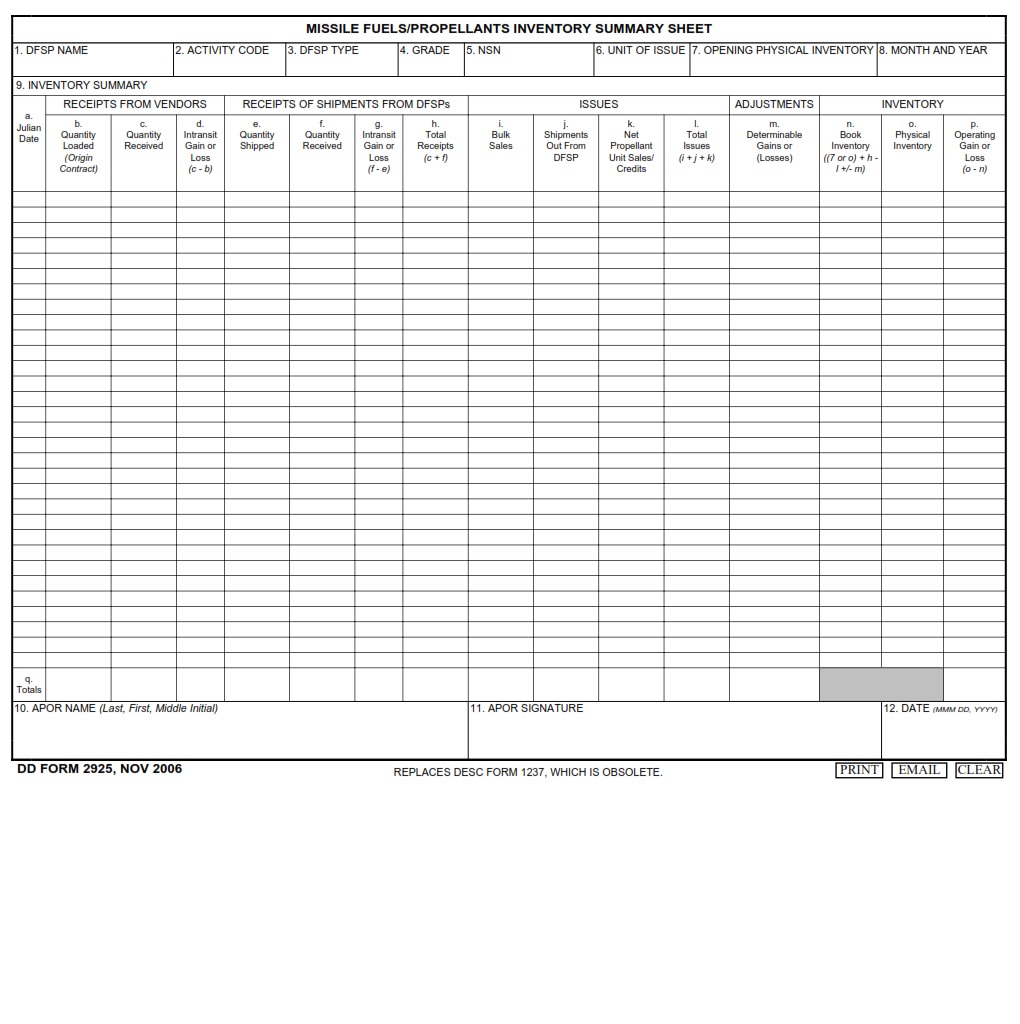DDFORMS.ORG – DD Form 2925 – Missile Fuels/Propellants Inventory Summary Sheet – The DD Form 2925 is a document designed by the United States Department of Defense to provide a comprehensive inventory summary of missile fuels and propellants. It serves as an essential tool for tracking the stockpiling, movement, and consumption of these critical materials used in military operations.
Through this form, military personnel can monitor the status of missile fuel and propellant storage locations, as well as identify any issues or discrepancies that may arise. The importance of this form lies in its ability to ensure that missiles are properly fueled and ready for use when needed while avoiding any unnecessary waste or shortages. In this article, we will take a closer look at the DD Form 2925, its purpose, and how it is utilized within the military supply chain.
Download DD Form 2925 – Missile Fuels/Propellants Inventory Summary Sheet
| Form Number | DD Form 2925 |
| Form Title | Missile Fuels/Propellants Inventory Summary Sheet |
| Edition Date | 11/1/2006 |
| File Size | 131 KB |
What is a DD Form 2925?
The DD Form 2925 is a document used by the United States Department of Defense to keep track of missile fuels and propellants. It serves as an inventory summary sheet that provides information about the types and quantities of these materials, as well as their locations within military facilities.
This form is important for ensuring that there are no shortages or overages of missile fuels and propellants, which could potentially lead to safety hazards or operational issues. It allows military personnel to easily monitor stock levels and plan for replenishment when necessary.
Overall, the DD Form 2925 plays a crucial role in maintaining the readiness and efficiency of military operations that rely on missile fuels and propellants. By accurately tracking these materials, it helps ensure that they are available when needed for critical missions.
Where Can I Find a DD Form 2925?
The DD Form 2925 is a Missile Fuels Propellants Inventory Summary Sheet used by the Department of Defense to keep track of missile fuels and propellant inventory. This form contains information such as the type of fuel or propellant, quantity on hand, and storage location. It is important for military personnel to know where they can find this form in order to accurately track their inventory.
One place to find the DD Form 2925 is on the Defense Logistics Agency’s website. They have an entire section dedicated to forms and publications, including this specific form. Additionally, military bases may have copies available in their supply or logistics departments.
It’s also worth noting that while physical copies of the form are still used, many bases and units have moved toward digital record-keeping systems. In these cases, personnel may be able to access the DD Form 2925 through secure online portals or databases provided by their respective branches of service.
DD Form 2925 – Missile Fuels/Propellants Inventory Summary Sheet
The DD Form 2925 is a document that summarizes the inventory of missile fuels and propellants. It provides details of the quantities, types, and locations of these materials. The form is used by personnel responsible for managing missile fuel and propellant stocks to ensure compliance with safety regulations and to maintain accurate records.
The information on the DD Form 2925 includes the date of inventory, location of storage facilities, opening stock balance, receipts during the period under review, issues made during the same period, and closing stock balances. The form also includes details on any discrepancies found during physical counts or inspections.
This document is an essential tool in ensuring that there are sufficient supplies of missile fuels and propellants for operations while keeping track of their use. It helps prevent accidents that may occur when handling dangerous chemicals by providing a clear understanding of what materials are available at any given time. Additionally, it assists in forecasting future needs based on past usage rates to ensure timely replenishment.
